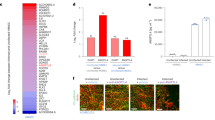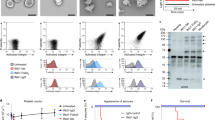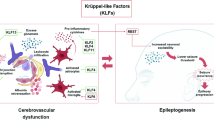Abstract
The mechanisms involved in the pathogenesis of epilepsy, a chronic neurological disorder that affects approximately one percent of the world population, are not well understood1,2,3. Using a mouse model of epilepsy, we show that seizures induce elevated expression of vascular cell adhesion molecules and enhanced leukocyte rolling and arrest in brain vessels mediated by the leukocyte mucin P-selectin glycoprotein ligand-1 (PSGL-1, encoded by Selplg) and leukocyte integrins α4β1 and αLβ2. Inhibition of leukocyte-vascular interactions, either with blocking antibodies or by genetically interfering with PSGL-1 function in mice, markedly reduced seizures. Treatment with blocking antibodies after acute seizures prevented the development of epilepsy. Neutrophil depletion also inhibited acute seizure induction and chronic spontaneous recurrent seizures. Blood-brain barrier (BBB) leakage, which is known to enhance neuronal excitability, was induced by acute seizure activity but was prevented by blockade of leukocyte-vascular adhesion, suggesting a pathogenetic link between leukocyte-vascular interactions, BBB damage and seizure generation. Consistent with the potential leukocyte involvement in epilepsy in humans, leukocytes were more abundant in brains of individuals with epilepsy than in controls. Our results suggest leukocyte-endothelial interaction as a potential target for the prevention and treatment of epilepsy.
This is a preview of subscription content, access via your institution
Access options
Subscribe to this journal
Receive 12 print issues and online access
$209.00 per year
only $17.42 per issue
Buy this article
- Purchase on SpringerLink
- Instant access to full article PDF
Prices may be subject to local taxes which are calculated during checkout




Similar content being viewed by others
References
Strzelczyk, A., Reese, J.P., Dodel, R. & Hamer, H.M. Cost of epilepsy: a systematic review. Pharmacoeconomics 26, 463–476 (2008).
Holmes, G.L. Seizure-induced neuronal injury: animal data. Neurology 59, S3–S6 (2002).
Duncan, J.S. Seizure-induced neuronal injury: human data. Neurology 59, S15–S20 (2002).
Vezzani, A. Inflammation and epilepsy. Epilepsy Curr. 5, 1–6 (2005).
Vezzani, A. & Granata, T. Brain inflammation in epilepsy: experimental and clinical evidence. Epilepsia 46, 1724–1743 (2005).
Seiffert, E. et al. Lasting blood-brain barrier disruption induces epileptic focus in the rat somatosensory cortex. J. Neurosci. 24, 7829–7836 (2004).
Ivens, S. et al. TGF-β receptor–mediated albumin uptake into astrocytes is involved in neocortical epileptogenesis. Brain 130, 535–547 (2007).
Van Vliet, E.A. et al. Blood-brain barrier leakage may lead to progression of temporal lobe epilepsy. Brain 130, 521–534 (2007).
Marchi, N. et al. In vivo and in vitro effects of pilocarpine: relevance to ictogenesis. Epilepsia 48, 1934–1946 (2007).
Luster, A.D., Alon, R. & von Andrian, U.H. Immune cell migration in inflammation: present and future therapeutic targets. Nat. Immunol. 6, 1182–1190 (2005).
Ransohoff, R.M., Kivisakk, P. & Kidd, G. Three or more routes for leukocyte migration into the central nervous system. Nat. Rev. Immunol. 3, 569–581 (2003).
Shibley, H. & Smith, B.N. Pilocarpine-induced status epilepticus results in mossy fiber sprouting and spontaneous seizures in C57BL/6 and CD-1 mice. Epilepsy Res. 49, 109–120 (2002).
Gröticke, I., Hoffmann, K. & Löscher, W. Behavioral alterations in the pilocarpine model of temporal lobe epilepsy in mice. Exp. Neurol. 207, 329–349 (2007).
Fabene, P.F., Marzola, P., Sbarbati, A. & Bentivoglio, M. Magnetic resonance imaging of changes elicited by status epilepticus in the rat brain: diffusion-weighted and T2-weighted images, regional blood volume maps and direct correlation with tissue and cell damage. Neuroimage 18, 375–389 (2003).
Piccio, L. et al. Molecular mechanisms involved in lymphocyte recruitment in brain microcirculation: critical roles for PSGL-1 and trimeric Gαi linked receptors. J. Immunol. 168, 1940–1949 (2002).
Glien, M. et al. Repeated low-dose treatment of rats with pilocarpine: low mortality but high proportion of rats developing epilepsy. Epilepsy Res. 46, 111–119 (2001).
Klitgaard, H., Matagne, A., Veneste-Goemaere, J. & Margineanu, D.G. Pilocarpine-induced epileptogenesis in the rat: impact of initial duration of status epilepticus on electrophysiological and neuropathological alterations. Epilepsy Res. 51, 93–107 (2002).
Racine, R.J. Modification of seizure activity by electrical stimulation. II. Motor seizure. Electroencephalogr. Clin. Neurophysiol. 32, 281–294 (1972).
Ley, K. & Kansas, G.S. Selectins in T-cell recruitment to non-lymphoid tissues and sites of inflammation. Nat. Rev. Immunol. 4, 325–335 (2004).
Ley, K., Laudanna, C., Cybulsky, M.I. & Nourshargh, S. Getting to the site of inflammation: the leukocyte adhesion cascade updated. Nat. Rev. Immunol. 7, 678–689 (2007).
Oby, E. & Janigro, D. The blood-brain barrier and epilepsy. Epilepsia 47, 1761–1774 (2006).
Lebwohl, M. et al. A novel targeted T-cell modulator, efalizumab, for plaque psoriasis. N. Engl. J. Med. 349, 2004–2013 (2003).
Polman, C.H. et al. A randomized, placebo-controlled trial of natalizumab for relapsing multiple sclerosis. N. Engl. J. Med. 354, 899–910 (2006).
Maly, P. et al. The alpha(1,3)fucosyltransferase Fuc-TVII controls leukocyte trafficking through an essential role in L-, E- and P-selectin ligand biosynthesis. Cell 86, 643–653 (1996).
Homeister, J.W. et al. The alpha(1,3)fucosyltransferases FucT-IV and FucT-VII exert collaborative control over selectin-dependent leukocyte recruitment and lymphocyte homing. Immunity 15, 115–126 (2001).
Xia, L. et al. P-selectin glycoprotein ligand-1–deficient mice have impaired leukocyte tethering to E-selectin under flow. J. Clin. Invest. 109, 939–950 (2002).
Runge, V.M. et al. The use of Gd DTPA as a perfusion agent and marker of blood-brain barrier disruption. Magn. Reson. Imaging 3, 43–55 (1985).
Lowell, C.A., Fumagalli, L. & Berton, G. Deficiency of Src family kinases p59/61hck and p58c-fgr results in defective adhesion-dependent neutrophil functions. J. Cell Biol. 133, 895–910 (1996).
Battistini, L. et al. CD8+ T cells from patients with acute multiple sclerosis display selective increase of adhesiveness in brain venules: a critical role for P-selectin glycoprotein ligand-1. Blood 101, 4775–4782 (2003).
Constantin, G. et al. Chemokines trigger immediate β2 integrin affinity and mobility changes: differential regulation and roles in lymphocyte arrest under flow. Immunity 13, 759–769 (2000).
Acknowledgements
Antibody to PSGL-1 (4RA10) was kindly provided by D. Vestweber, Max Plank Institute. We wish to thank C. Laudanna for critically discussing the manuscript. This work was supported in part by grants from the Fondazione Cariverona, Ministero dell'Università e della Ricerca (MIUR)–Progetti di ricerca di interese nazionale, the US National Multiple Sclerosis Society, Fondo Incentivazione Ricerca di Base, the Italian Ministry of Health; Fondazione Italiana Sclerosi Multipla, the University of Verona ex 60% MIUR (to G.C.); the European Community Research Grants LSH-CT-2006-037315 (EPICURE, thematic priority LIFESCIHEALTH; University of Verona ex 60% MIUR (to P.F.F.); and by US National Institutes of Health grants (to E.C.B., L.X., R.P.M. and J.B.L.). L.O. was supported in part by a fellowship from Fondazione Italiana Sclerosi Multipla. The authors are grateful to S. Fiorini, I. Cwojdzinski, P. Bernardi, M. Pellitteri, S. Becchi, L. Andrello and A. Calbi for their invaluable help in the experimental procedures.
Author information
Authors and Affiliations
Contributions
G.N.M., D.B., A.C., L.Z. and F.S. performed epilepsy experiments, telemetry and open field behavior. M.M., B.R., L.O., S.B. and S.A. performed intravital microscopy, in vivo staining for adhesion molecules, adhesion assays and contributed to obtaining the behavioral data. A.O. provided the human samples. F.M., A.C. and F.O. performed immunohistochemistry on human and animal samples. P.M., E.N. and A.S. provided MRI expertise. J.W.H., L.X., J.B.L. and R.P.M. provided key reagents and mice. E.C.B. contributed experimental suggestions, reagents and assistance with writing. P.F.F. and G.C. designed the study, analyzed the data and wrote the paper.
Corresponding authors
Supplementary information
Supplementary Text and Figures
Supplementary Figs. 1–4, Supplementary Tables 1–3, Supplementary Methods and Supplementary Discussion (PDF 587 kb)
Supplementary Video 1
This movie shows SE-induction in WT mice after pilocarpine administration paralleled by the normal behavior of mice lacking fucosyltransferase (FucT)-VII activity (MOV 2391 kb)
Rights and permissions
About this article
Cite this article
Fabene, P., Mora, G., Martinello, M. et al. A role for leukocyte-endothelial adhesion mechanisms in epilepsy. Nat Med 14, 1377–1383 (2008). https://doi.org/10.1038/nm.1878
Received:
Accepted:
Published:
Issue Date:
DOI: https://doi.org/10.1038/nm.1878
This article is cited by
-
Leukocyte differential gene expression prognostic value for high versus low seizure frequency in temporal lobe epilepsy
BMC Neurology (2024)
-
Blood–brain barrier disruption following seizures
Nature Reviews Neurology (2023)
-
Effects of Diclofenac Sodium on Seizure Activity in Rats with Pentylenetetrazole-Induced Convulsions
Neurochemical Research (2023)
-
Microvascular stabilization via blood-brain barrier regulation prevents seizure activity
Nature Communications (2022)
-
sVCAM1 in the Hippocampus Contributes to Postoperative Cognitive Dysfunction in Mice by Inducing Microglial Activation Through the VLA-4 Receptor
Molecular Neurobiology (2022)



